While attention to the global climate crises is on the rise, humanity faces an array of interlocking ecological issues that also includes massive loss of biodiversity, pervasive declines in fresh water and fertile top soil, deforestation, and pollution.
Communicating the depth and breadth of these challenges along with their intersecting social justice implications is its own pursuit and not the focus of One Earth Sangha.
Yet some amount of common understanding of the challenges we face is necessary in order for us to move forward as a community. In that interest, we offer this primer on the climate crisis in particular and will be providing summaries of the other core issues over the next year. We encourage our members to explore and share other sources in order to stay reasonably abreast of ecological crises and their uneven impacts on the living Earth community.
Skillful Means
Opening to information about our situation is not easy to bear. We suggest that this is a place for your practice.
Consider preparing with this article from Lama Willa Miller. Alternatively, you can create your own practice, starting with affirming goodness or the refuges. As you take in the information, stay attuned to and compassionate with your experience. You might conclude with metta (loving-kindiness) or another heart practice.
An Overview of the Climate Crisis
This primer was developed by in 2015 by Lou Leonard, One Earth Sangha’s co-founder and a head of the climate program at World Wildlife Fund and Kritee (Kanko), senior scientist at Environmental Defense Fund. They presented this as part of the opening of first EcoSattva Training, the Sickness is Medicine, as a way to summarize the basic science of the climate crisis. While scientific analysis has of course evolved since then, the tenets of the phenomenon and the challenge that it presents to humanity presented here remain sound. We offer this as a means of shared language and understanding.
Table of Contents
SECTION I. THE CLIMATE SCIENCE BASICS
- Are “global warming” and “climate change” the same phenomena?
- What do we confidently know about climate change?
- What is the cause of climate change?
- What is needed to address climate change?
- Are we seeing effects already that are related to climate change and fossil fuel pollution?
- Is there still hope?
SECTION II. WHAT’S HAPPENING TO ADDRESS CLIMATE CHANGE?
- What are the governments of the world doing to address climate change?
- What are the fairness and justice implications of a climate change response?
- Can I make a difference?
SECTION III. GOING DEEPER ON CLIMATE SCIENCE
- How do we know what we know?
- Who are the scientists involved?
- What are climate “tipping points” and how close are we to hitting them?
- Is there much disagreement among scientists?
- Why is crossing of 400 ppm CO2 concentration a big deal?
- Is carbon dioxide the only greenhouse gas?
SECTION IV. RESOURCES FOR ADDITIONAL INFORMATION
SECTION I. THE CLIMATE SCIENCE BASICS
1. Are “global warming” and “climate change” the same phenomena?
Climate change and global warming often are used inter-changeably. In truth, they are related but different.
Global warming refers only to the increase in Earth’s global average temperature due to human caused greenhouse gas pollution. Greenhouse gas emissions thicken the “blanket” of gases that trap heat in our atmosphere. Before the beginning of industrial activities on the planet, this blanket kept Earth warm enough for life. Now, Earth’s temperature is increasing because of increasing heat being trapped by this ever thickening atmospheric blanket. If we don’t stop now, we could see up to 11°F increase in Earth’s temperature in the lifetimes of our children and grandchildren.
“Climate change”, on the other hand, is a more over-arching term describing broader changes in our ocean, atmosphere and ice sheets due to increasing greenhouse gas pollution. Climate change can refer to historical changes in Earth’s climate due to natural causes, so you may hear people say that “climate change” has been happening for millions of years. But human-caused greenhouse gas pollution is changing the natural rules of the game and producing a new and unprecedented set of changes on Earth. This human-caused climate change refers to recent changes (including global warming, sea-level rise, reduction in ocean’s pH, increased droughts, change in rainfall patterns, loss of polar sea-ice, etc.).
Here after, we’ll use “climate change” as shorthand for global warming and other changes related to human greenhouse gas pollution.
2. What do we confidently know about climate change?
The consensus among climate scientists (see more below) is that:
-
-
- global warming and the resultant climate change is happening already in all parts of the world,
- it is human-caused due to burning of fossil fuels and destructive land use practices, and
- it will continue to get worse.
-
This year, the world’s most respected group of climate scientists summarized climate change this way:
Warming of the climate system is unequivocal, and since the 1950s, many of the observed changes are unprecedented over decades to millennia. The atmosphere and ocean have warmed, the amounts of snow and ice have diminished, sea level has risen, and the concentrations of greenhouse gases have increased.
(IPCC, 2013: Summary for Policymakers)
Earth’s climate is a complex system, so scientists continue to learn about it every day, including becoming better at predicting future changes and understanding how different parts of the system (e.g., ocean currents, atmospheric conditions, polar ice sheets) affect each other. But there is no disagreement among climate scientists about the basics of climate change.
Despite the fact that some worsening of climate is inevitable, scientists agree that we likely can still avoid the worst impacts of climate change if we act now to move to a zero-carbon future within the coming decades and prepare for the impacts (“adapt” to changes) we can’t avoid.
3. What is the cause of climate change?
The current climate change is caused by rapidly increasing concentration of greenhouse gases like carbon dioxide (CO2) in the atmosphere. The burning of fossil fuels (oil, coal, natural gas) and the destruction of forests (and conversion of forests and grasslands into crop-lands) releases CO2.
After decades of careful geochemical research on ancient air trapped in ice, scientists have discovered that changes in the amount of carbon dioxide in the air and changes in air temperature are very closely associated. Throughout geological time (i.e, hundreds of thousands of years), when CO2 in the atmosphere has been high, the temperature has been high as well. The two track each other very closely.
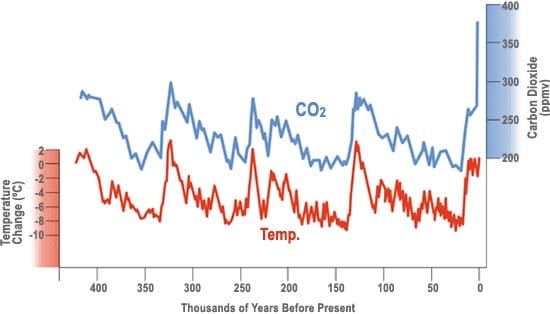
As Figure 1 shows, in recent decades CO2 (blue line) has increased an unprecedented amount in a very short time. The corresponding change in temperature (red line) has not yet caught up with the quick increase in CO2 due to a time lag between when greenhouse gases are emitted into the atmosphere and when their full warming effect is felt. Similar to the effect of CO2, most other greenhouse gases also remain in the atmosphere for decades or more, so even when we stop emitting these gases we will feel worsening impacts for years to come (see more in the section Going Deeper on Climate Science).
4. What is needed to address climate change?
In short, we need to use less energy, replace fossil fuels with renewable energy (like wind and solar) for our remaining energy needs, and adopt land use practices that stop deforestation and unsustainable agriculture. As we noted earlier, even if we stopped all carbon pollution today, impacts would continue to increase for some time due to the time lag in our climate system. So, it is important that we both move to eliminate fossil fuels, and begin to prepare for the impacts we can’t avoid through smarter planning and actions to improve the resilience of communities to stronger and more frequent storms, droughts, heat waves and sea level rise. And of course building our own psychological resilience to large, harmful changes in the world around us is vital to achieving everything else.
The world’s top 200 fossil fuel companies have 2,795 gigatons of CO2 in their traditional fossil fuel reserves, plus more in unconventional sources like tar sands, oil shale and methane hydrates. According to a recent analysis, to limit global average warming to 2 degree Celsius, we will need to avoid burning about 2/3 of this large amount of fossil fuels that have been discovered but not yet exploited. Specifically, to have an 80 percent chance of avoiding the two degree threshold, we would have to emit less than ~550 gigatons CO2e. This would result in large amounts of “assets” of major fossil fuel companies becoming valueless. Therefore, away from fossil fuels will have consequences for some businesses which are opposing the much needed transition.
Thankfully, many analyses exist that show it is technically possible for the world to move to 100% renewable energy in the coming decades and dramatically reduce greenhouse gas emissions to the levels science requires. Recent reductions in the cost of renewable energy technologies (for example, the price of solar panels has dropped 99% since 1977 and 60% over the last 5 years) are making these technologies cost-competitive with fossil fuels. In the first quarter of 2014, 92% of the new electricity generating capacity built in the United States came from wind and solar!
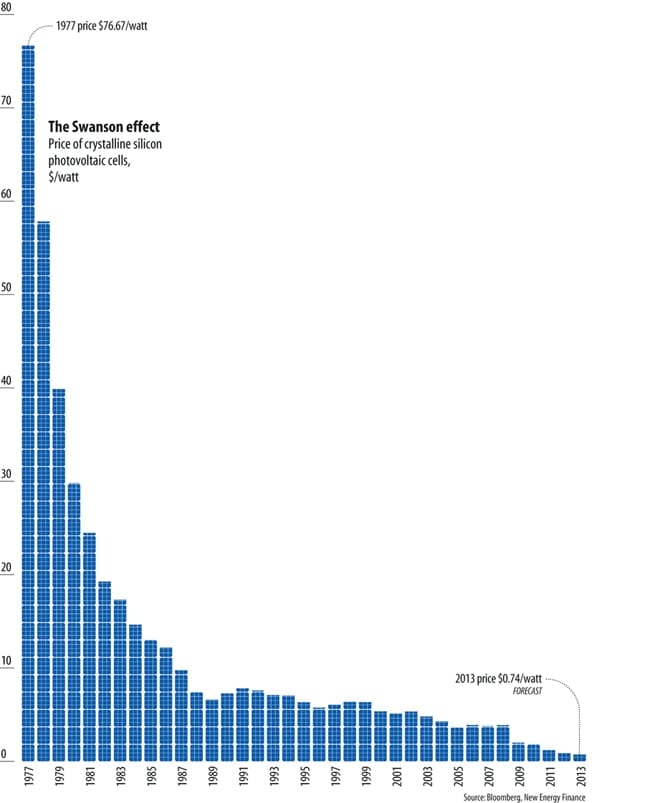
Many studies, including an authoritative study by the UK government, show that the cost of the transition to clean energy will be relatively modest (only reducing the increase in economic growth over the next 50 years).
5. Are we seeing effects already that are related to climate change and fossil fuel pollution?
Until about 5-10 years ago, observable impacts from climate change were not fully clear. So some scientists referred to extreme weather events as “the kind that we expect to occur more frequently in the future” due to climate change without ascribing the current events to climate change that has already occurred. Now, however, there is a growing body of accepted science that demonstrates with ever-increasing degrees of confidence that impacts (and extreme weather events) we are seeing today are caused by human-created climate change. In general, climate change has put weather on steroids and is already making usual week-to-week or year-to-year fluctuations in weather more extreme than they would be without climate change.
Because the ocean absorbs about a quarter of the CO2 we release into the atmosphere every year, the levels of CO2 dissolved in the ocean has also increased as the planet has warmed up. Decades of ocean observations now show that the CO2 absorbed by the ocean is changing the chemistry of the seawater, a process called ocean acidification. Increasing acidity of our ocean is already causing harm to life at the base of aquatic food chain by dissolving shells and crusts of marine animals and has potential to cause a lot of damage to marine life.
These currently observable impacts are only a small sample of what is expected in the future if we stay on our current path of fossil fuel use and unsustainable forest and land-use. A group including Hank Paulson (George W. Bush’s Treasury Secretary) and Mayor Michael Bloomberg recently assessed the risks facing each region of the United States and the trillions of dollars of potential costs that lie ahead from climate change impacts. And recall that there is a time delay in our climate system, so the impacts we are experience today are due to pollution emitted decades ago. So we are not yet feeling all of the effects of the pollution we have already emitted.
6. Is there still hope?
This may be the most important decade in human history. There is still time to shape our future. What we do today and during the next few years matters so much. The graph below shows an important “fork in the road” before 2020. On one path (Figure 3, scenarios in red), we continue with business as usual, global temperatures increase by 3-6°C leading to dangerous tipping points and great suffering. Another path (scenarios in blue) gives us a good chance of staying below 2 degrees Celsius and limiting our impact on ourselves, future generations and all life on our Earth. The fork is ahead of us, not in the rearview mirror. Everything we do to help move onto the right path helps. You can really make a difference through your actions at home, your choice of energy and food, and by speaking up and voting like our world depends on it, because it does.
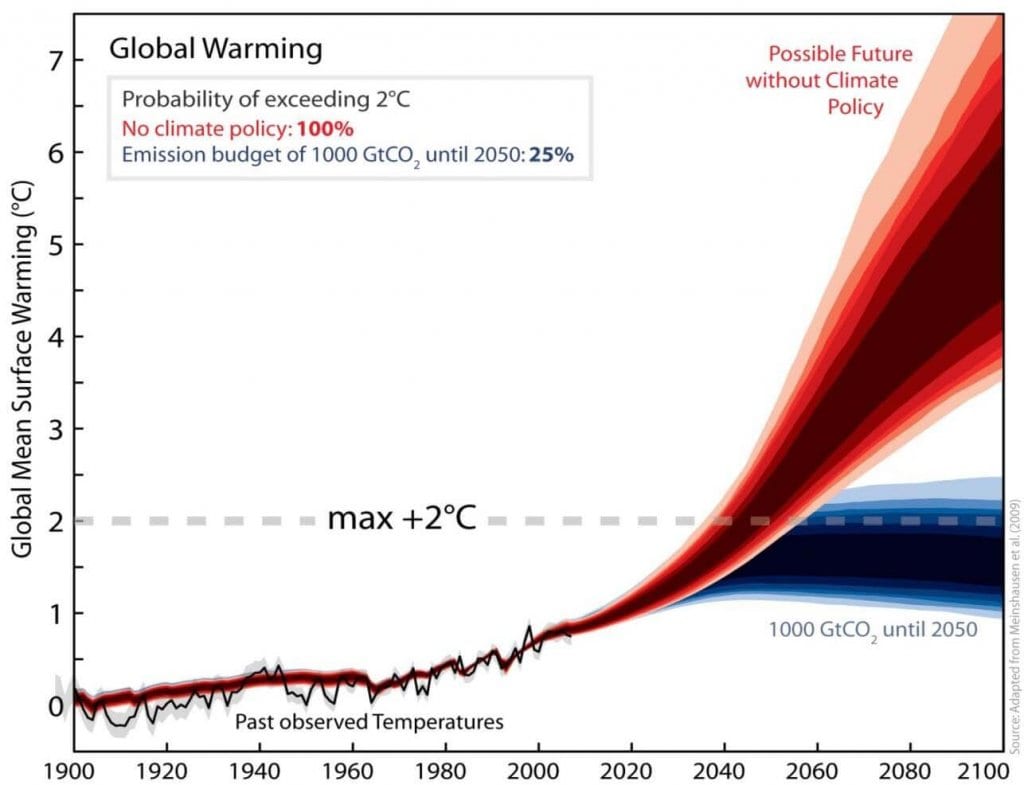
SECTION II. WHAT’S HAPPENING TO ADDRESS CLIMATE CHANGE?
7. What are the governments of the world doing to address climate change?
There is no disagreement among governments across the globe that climate change is occurring and it is human-caused. As early as 1992, a treaty was executed by 193 countries, including the United States, calling for action on climate change and creating a framework for governments to work together to address it. In 1997, that treaty was amended by the Kyoto Protocol to require specific pollution cuts from countries that had industrialized earlier and so were responsible for most climate pollution. When George W. Bush withdrew from the Kyoto Protocol, the United States became one of only 3 countries to reject it (Afghanistan and Sudan were the others). In 2009 in Copenhagen and at UN meetings thereafter, countries agreed to the goal of limiting global warming to less than 2 degrees Celsius; over 100 countries (including the United States, China, and Europe) made individual pledges to cut climate pollution by specific amounts by 2020.
Although not legally binding, many countries are on track to meet these pledges, including the United States, Europe and China. Unfortunately, the pledges collectively were too weak (at best resulting in only 60% of the cuts needed to get on a path to limit warming to 2°C). Right now, countries are negotiating a new agreement to do more in the short term and to cut pollution further by 2025. The deadline for countries to submit new commitments is March 2015; agreement on a new treaty is scheduled to be completed by December 2015.
At the national level, progress is being made to reduce emissions and transition away from fossil fuels. In the United States, emissions are decreasing and currently 10% below 2005 levels; many coal plants are shutting down and no new coal plants are expected to be built in the future; and new regulations to reduce climate pollution from cars, truck and electric power plants are in place or under development pursuant to President Obama’s climate action plan. Europe has a system in place to reduce emissions from the region by 20% by 2020. Countries like Germany (which is implementing a high-profile transition off of fossil fuels to clean energy) and Denmark (which generated more than 100% of its power needs from wind in November 2013) are using very high levels of renewable energy. China is investing more in renewable energies like solar and wind than any other country and currently has the most installed solar and wind capacity in the world.
So governments are doing more, but not fast enough. And some countries, like Australia, Canada and Japan are repealing domestic laws or signaling that they will not meet their international pledges. Negotiations leading to Paris will be very important.
8. What are the fairness and justice implications of a climate change response?
As with most disasters and societal disruptions, the impacts of climate change will hit the poor and those will less political power the hardest. Those communities with few financial resources to address heat-waves, growing storms and rising seas will suffer more. Livelihood of small scale farmers in Asia and Africa, who grow the majority of global food but live in areas which are drought prone, are at increasing risk. This is true both within countries (migrant farm workers or inner-city communities in the United States will suffer more than the wealthier suburbs or Wall Street executives) and between countries (low-lying and under-resourced Bangladesh will suffer more than Germany). Any fair solution to climate change will take these differences into account and provide attention and financial resources to support more vulnerable countries and populations.
What may be less obvious is that our approach to addressing climate change and other environmental problems can also have negative impacts to vulnerable populations and communities. For example, during the push for a mercury rule in the United States in 2008, a “cap-and-trade” mechanism would have reduced emissions overall, but given power generating companies flexibility keep some existing coal plants running with negative impacts to poorer communities of color living near those plants. There also is a growing movement for a “just transition” away from fossil fuels that takes into account the potential economic impacts to workers and communities who currently rely on fossil fuel development for their livelihood.
The equity issues around our response to climate change play out across countries as well. In the United States, politicians often talk about “China and India” being the real problem. But the United States is the single largest historical contributor to the climate crisis and the world’s largest economy. US per capita emissions today are 3 times those of China, 4 times those of Mexico and 10 times those of India. And of course small island nations and countries in Africa which face the greatest threats from climate change, have done virtually nothing to contribute to the crisis and have very little capacity or resources to prepare or adapt. So any fair solution, must recognize that countries like the United States need to play a leadership role regardless of the actions of others, and a global solution must provide ways to provide financial and other support to protect the vulnerable.
9. Can I make a difference?
Yes! Climate change impacts all aspects of our lives (food, water, energy, transport, our cities), which means there are so many ways to be part of the solution. When we turn into the suffering of climate change, energy and creativity can emerge, leading us to our own authentic response. Here are some ideas to get you started and there are more resources at the end of this paper:
Let’s start with the US electricity system in the United Sates as just one example: Electricity use is the largest source of US climate pollution (35%). Big change is happening right now in this system because of collective action by groups of individuals, cities and businesses. This is something you can contribute to by cutting energy waste in your home, switching to renewable power and working in your community to move to 100% renewable energy. By getting a group of neighbors or coworkers to purchase solar panels together (learn more here), for instance, you can save on costs and make even bigger change (think of it as a ‘solar sangha’). You can read more about this quiet revolution in our electricity system here.
The slow pace of political change can be the most frustrating aspect of the change we need, especially in the United States, where climate change remains politically divisive. But policy action is crucial and political change can be hard to see coming until it arrives (think of the Berlin Wall, recent laws on gay marriage, the election of an African American president). A new social media app #climate collects opportunities to support political change from many different groups. As we remain engaged in the political process, it can be interesting to note the mind’s desire to know whether we are making a difference. Are there other good reasons to engage in right action besides knowing we have produced a clear impact?
In fact, some of the most dangerous impacts of climate change happen in our own minds. The psychological literature shows that people tend to feel guilty, overwhelmed and powerless in the face of a challenge this big. Many shut down entirely, taking no action. Others become overcome with fear and are unable to maintain sustained action. By increasing our awareness of our emotional response to climate change, we can become more resilient and engage more consistently. When individuals and communities create a wise and compassionate spaces to face and process fear, denial and anger, these energies can be transformed into confidence, clarity and action. So by signing up for the “Mindfulness and Climate Action” class you are already engaging in this important kind of climate action. Thank you!
Perhaps the most basic step we can take is simply talking more about the climate crisis with our friends, our families, our coworkers. (It may be interesting to notice how your mind reacts to even the idea of speaking out more.) But by naming the elephant in the room, conversations begin, possibilities emerge. Social change research says that people are more likely to care about a problem if they see others around them doing the same.
Back to Table of Contents
SECTION III. GOING DEEPER ON CLIMATE SCIENCE
10. How do we know what we know?
The case for man-made global warming doesn’t hang on just models or theory – it’s built on direct measurements of many different parts of the climate, all pointing to a single, coherent answer. In order to be convinced that “global warming is already occurring”, different research analysis used in the last IPCC report used observations starting from year 1800 AD from as many as ~40,000 weather stations around the globe (read more here).
For temperature records before 1800s, scientists have relied on ice cores, which are cylinders of ice drilled out of an ice sheet or glacier, which enclose small bubbles of air that contain a sample of the atmosphere. These trapped air samples make it possible to measure directly the past concentration of gases (including carbon dioxide) in the atmosphere. Ice cores also contain information about past temperature, and about many other aspects of the environment. The oldest continuous ice core records to date extend 123,000 years in Greenland and 800,000 years in Antarctica.
11. Who are the scientists involved?
Intergovernmental Panel on Climate Change (IPCC) was first established in 1988 by two United Nations organizations, the World Meteorological Organization (WMO) and the United Nations Environment Programme (UNEP). It was created by governments to provide regular updates on climate science for use by government policy-makers and the public. The IPCC largely operates by consensus, so its conclusions are inherently conservative. Since 1988, IPCC has been producing three reports every 5 years. The first report covers details about the physical science but in much greater detail, second focuses on impacts of climate change in all possible parts of the world and what do we need to “adjust” to the changing climate. The third one focuses on technologies and processes that need to be pursued to reduce/stop/prevent greenhouse gas emissions. The last set of reports was released in 2013-2014 and was written by 1800 scientists + 1000s of reviewers from across 70 countries and incorporated 150,000 comments from all kinds of stake-holders. These reports incorporated staggering 30,000 peer reviewed publications. Do you know a hard working Ph.D. or Masters student? The IPCC reports showcase work of ~100,000 years of work by such graduate students.
In addition to the work of the IPCC, the top scientific bodies in many countries have issued reports on climate change that are consistent with the findings of IPCC. Earlier this year (2014) the National Academy of Sciences in the United States and the Royal Academy in the United Kingdom took the unusual step of creating a joint report on climate change for use by the general public. You can read the report here.
12. What are climate “tipping points” and how close are we to hitting them?
One particularly dangerous aspect of climate change is that human increased warming could reach a level where it triggers a series of “feedback loops” within Earth’s natural systems that accelerate warming in ways we can’t control and to levels human society could not tolerate. If we continue our current course of emissions, we will cross many dangerous tipping points. For example, the light-colored Arctic sea ice cap currently reflects sunlight away from Earth. When the white ice is replaced by dark ocean, sunlight will be absorbed producing more ocean heating, rather than reflected back to space. (In Figure 4, we are safe with respect to each tipping point only when global average temperature increase in within white range. The yellow/red areas denote the global warming ranges which can trigger tipping of Earth’s crucial functions and processes in catastrophic ways.) One of the most dangerous tipping points (which is not mentioned in the figure below) is when the atmosphere and oceans warm enough to melt “methane hydrates” currently trapped in arctic permafrost and under the ocean floor. Recent discovery of giant craters forming in the Siberian permafrost with very high methane concentrations is definitely a worrisome warning and indicates our closeness to a dangerous tipping point.
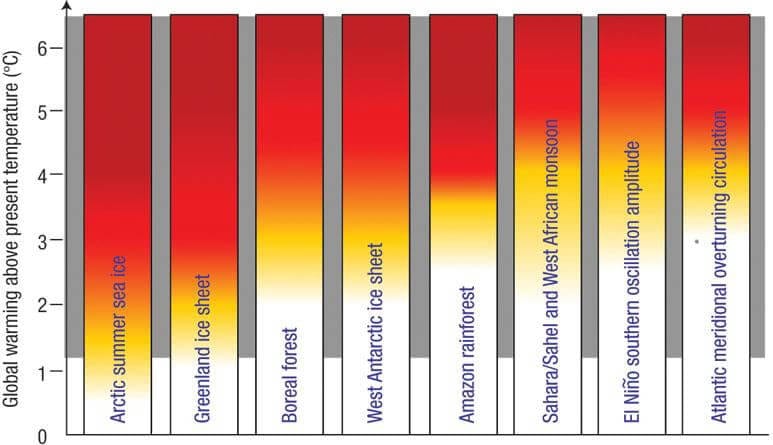
These tipping points could trigger massive loss of species and catastrophic changes all over the planet. Complete loss of Greenland ice sheet can increase global sea level by 7 meters! You can read more on tipping points from this 2013 report by the US National Academy of Sciences.
13. Is there much disagreement among scientists?
According to a recent assessment, 97% of the peer reviewed articles about climate change support the basic science, including the human cause. Recently, John Oliver comically noted that a true statistically valid debate on climate science should have 97% of attendees speaking in favor of climate with 3 allowed a chance to speak against it. As noted earlier, scientists might not all agree on the exact average global temperature in the future but it is a great misrepresentation to argue that scientists are still debating the basics of climate change (i.e., Global climate change is already happening; It is caused by human beings; and It will definitely get much worse if we don’t act now) when these points represent the core consensus of the scientific community.
14. Why is crossing of 400 ppm CO2 concentration a big deal?
As you can see in Figure 1, for hundreds of thousands of years Earth’s climate has cycled between 180 and 300 ppm. All the ice ages (including when 2 miles of ice covered places like Chicago) were associated with less than 200 ppm CO2; the pre-industrial period saw CO2 at approximately 280 ppm. Today we are close to 400 ppm. Our human species has never seen CO2 concentrations this high nor concentrations increasing this quickly. In fact, 400 ppm is 40% higher than the highest natural levels over the past 800,000 years, long before humans evolved.
The last time carbon dioxide concentrations were as high as they are now was 3-5 million years ago. At that time, global average temperatures were between 5.4 and 7.2 degrees Fahrenheit (3 to 4 degrees Celsius) higher than today, with sea level was as much as 130 feet (40 meters) higher in many places. Throughout time, Earth has experienced several periods of mass extinction associated with rapidly warming and natural releases of huge amounts of carbon. Last Hours describes these earlier extinctions and the role carbon emissions (particularly the release of methane currently frozen under the oceans). You might notice how your mind reacts to watching this difficult film.
We do not have such high sea levels and temperatures on Earth today because, as mentioned, it takes time for the emitted carbon dioxide to be fully experienced by Earth systems. And it does not appear that we have yet crossed some of those dangerous tipping points, but it is impossible to know for sure.
15. Is carbon dioxide the only greenhouse gas?
Carbon dioxide is the primary greenhouse gas but not the only one that we should be concerned about. Greenhouse gas pollution is created by burning fossil fuels (oil, coal, natural gas) and the destruction of forests (and conversion of forests and grasslands into crop-lands) which release carbon dioxide. Release of nitrous oxide (from inefficient use of fertilizers) and methane (from land-fills, livestock, and fracking, and natural gas wells & pipelines), and other heat-trapping chemicals, including many used in refrigeration also contribute to greenhouse pollution. Learn more about greenhouse gases at EPA’s website.
All of these gases trap more heat in our atmosphere than is needed to make Earth warm enough for life. Earth’s temperature is increasing from this thicker atmospheric blanket, both land surface temperature and also ocean temperatures. This increase is felt differently in different parts of the world due to air and ocean currents and other factors. For example, temperatures in the Arctic have increased by 2°C compared to historical averages, whereas average land-surface temperatures have increased over 0.7 degrees centigrade.
This doesn’t sound like a big increase, but Earth’s atmosphere and oceans are very sensitive to change. Even a 1.5 or 2°C increase is expected to cause significant damage to humans and natural systems. See Figure 4 above.
Back to Table of Contents
SECTION IV. RESOURCES FOR ADDITIONAL INFORMATION
Climate Science Information
Intergovernmental Panel on Climate Change (IPCC): Here you can access the 2014 comprehensive review of climate science information as well as past reports.
US Academy of Sciences: The highest scientific authority in the United States. It has produced a number of reviews of climate science, including a recent summary for the public produced together with The Royal Society.
The Royal Society: The United Kingdom’s most authoritative science body and one of the most respected in the world.
US National Climate Assessment: This report, commissioned by the US government, provides the most comprehensive analysis of the current and future impacts of climate change on the United States.
The Stern Review on the Economics of Climate Change: Commissioned by the UK Treasury, one of the most comprehensive assessments of the costs of the global impacts of climate change, as well as the cost of responding to it.
Skeptical Science: A well-respected online platform dedicated to providing clear, science-based answers to common questions about climate change.
Dr. James Hansen: One of the most outspoken climate scientists.
Renewable Energy Information
REN21: An organization dedicated to tracking renewable energy trends and progress in key countries. Releases a well-regarded annual summary of renewable energy development.
US National Renewable Energy Laboratory: Part of a network of US “national laboratories” supported by the Department of Energy, conducting cutting edge research on renewable energy.
Renewables 100 Policy Institute: A think tank and non-profit organization dedicated to promoting the transition to 100% renewable energy.
The Energy Report: A comprehensive roadmap created by WWF showing a pathway to 100% renewable energy globally by 2050.
About the Authors
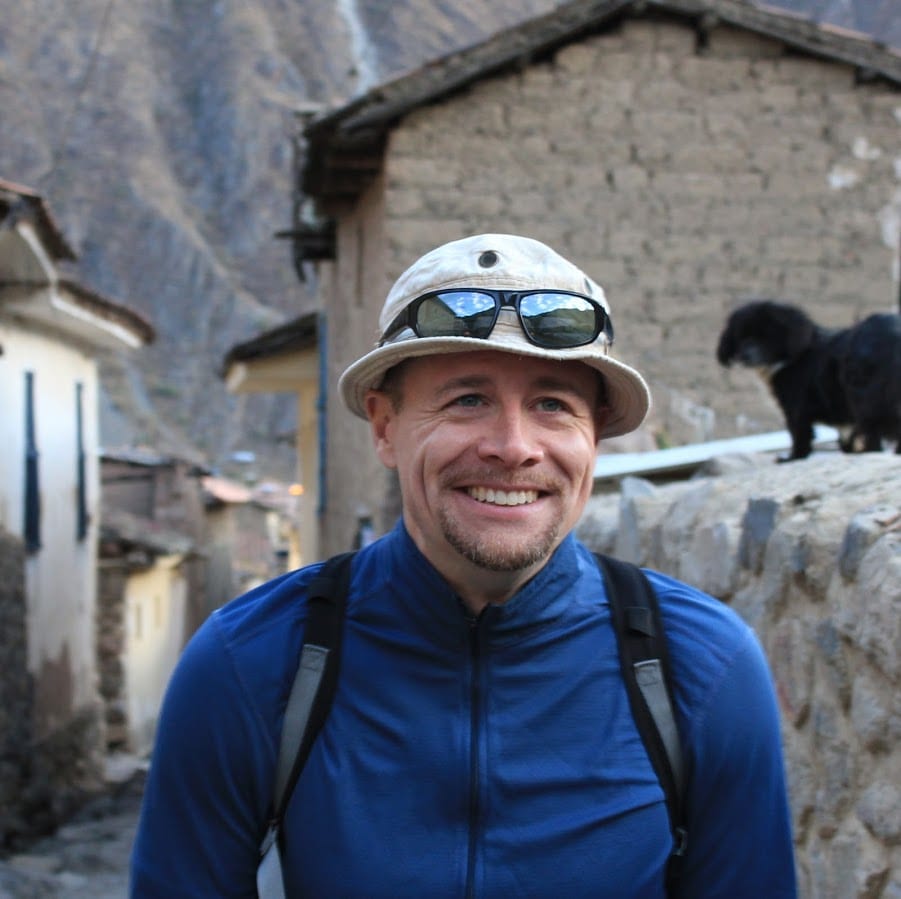
Lou Leonard is a life-long environmentalist who has worked to advance laws, policies and practices that promote care for the Earth and the people and communities that call it home. Lou discovered the dharma as part of his search for balance and support in the face of the difficult emotions that arise as we dedicate ourselves to healing the world and promoting social change. He’s worked in government, civil society, academia, and the private sector, including serving as Senior Vice President at World Wildlife Fund where he led the climate change program for over a decade. Lou currently serves as Dean of the Falk School of Sustainability & Environment at Chatham University supporting students of all ages who are training to advance climate and food justice. Lou is deeply grateful for the refuge he has found in the dharma and the teachers who have helped him find it.

Kritee (dharma name Kanko), is a Zen teacher, scientist, activist, dancer and permaculture designer. She directs and teaches Boundless in Motion Sangha in Boulder in the Rinzai-Obaku Buddhist lineage of Cold Mountain, is a co-founder and executive director of Boulder Eco-Dharma Sangha and co-founding teacher of Earthlovego. Kritee trained as an environmental microbiologist and biogeochemist at Rutgers and Princeton Universities. As a senior scientist in the Global Climate Program at Environmental Defense Fund, she is helping to implement environment and climate-friendly methods of small farming at large scales in Asia with a three-fold goal of poverty alleviation, food security and climate mitigation / adaptation.
***This paper was not developed in affiliation with either World Wildlife Fund or Environmental Defense Fund and may not reflect the formal or informal positions of the two organizations.
